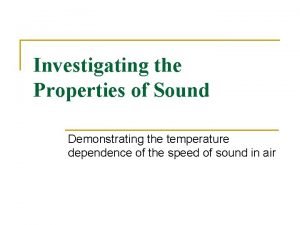INVESTIGATING THE DEVELOPMENT OF LETTER PERCEPTION USINGGPPI CONNECTIVITY

- Slides: 1

INVESTIGATING THE DEVELOPMENT OF LETTER PERCEPTION USINGGPPI CONNECTIVITY ANALYSIS VINCI -BOOHER , S. , ENGELHARDT , L. , JAMES , T. W. , & JAMES , K. H. DEPARTMENT OF PSYCHOLOGICAL AND BRAIN SCIENCES, INDIANA UNIVERSITY ANALYSIS PURPOSE To investigate the effects of learning letters through handwriting on the development of a letter perception functional brain network. BACKGROUND 5 Interactions Typical brain areas: fusiform gyrus (Fu. G) precentral gyrus (Pr. G) inferior frontal gyrus (IFG) middle frontal gyrus (MFG) inferior parietal lobe (IPL) cuneus Letter learning reinforced through handwriting 1 (1) facilitates letter recognition and (2) increases BOLD signal from L Fu. G during letter perception 2, when compared to visual-only letter learning. Child letter perception 4 Child letter perception: Adult letter perception : 3 after printing practice : (g. PPI) Preprocessing of f. MRI images done in Brain. Voyager QX. Generalized Psychophysiological analysis performed using average BOLD activity of the seed (R): Seed definition: Functionally localized Y= β 0+ β 1 X 1+ … + β 8 X 8+β 10 R+ β 11 RX 1+ … +β 18 RX 8+ε, for each individual where β 11 through β 18 correspond to g. PPI β-weights using the contrast: for conditions 1 through 8. d. Lets+tr. Lets+ty. Lets>3 fixation. Seeds chosen for L Fu. G and R Fu. G. Monte Carlo simulations to cluster correct to p<0. 05. RESULTS &CONCLUSIONS 1: Practice Learning letters through any motor activity promotes an increase in synchronous activity between z=43 L Fu. G & R IPS/IPL and an increase in synchronous activity between R Fu. G & R cuneus during letter perception. seed: L Fu. G (red); d. Let+tr. Let +ty. Let > c. Let R L R R L L Other regions of interest: postcentral gyrus (Po. G), intraparietal sulcus (IPS), anterior cingulate gyrus(ACC). Visuospatial ~practice 3 METHODS R IPS/IPL R R cuneus Preliterate 5 y/o (56. 6 m, s. d. =4. 02) children (n=11, 6 female). Training: Different sets of letters and shapes were reinforced through different manipulations of the fine motor system. 2: Printing experience Learning letters through printing promotes an increase in z=53 synchronous activity between L Fu. G & L Pr. G and L Po. G during letter perception. seed: L Fu. G (red); d. Let>ty. Let R ACC 10 s 1. 0 s 0. 5 s Draw Shape 24 s Trace Shape 10 s Type Letter Draw Letter 24 s ~printing experience L Po. G L ACC Letters & shapes R R Fu. G L L IFG After handwriting practice, letter perception is supported by a set of visuospatial, sensorimotor, and premotor areas that function synchronously with letter perception areas. 4: 55 Trace Letter L Pr. G 3: Stimulus form Learning letters, not shapes, through printing z=18 promotes an increase in synchronous activity between L Fu. G & L MFG/L IFG during letter perception. Learning shapes, not letters, through printing promotes an increase in synchronous activity between R Fu. G & L MFG and ACC during shape perception. L MFG f. MRI session: Passively viewed letters and shapes that were learned through the different training methods. Type Shape L Sensorimotor seed: L Fu. G (red); d. Let > d. Sh seed: R Fu. G (blue): d. Sh > d. Let Control Shape Control Letter 10 s 1 Longcamp et al. , 2005; 2 James, 2010; 3 James & Engelhardt, 2012; 4 James & Gauthier, 2006; 5 Mc. Laren et al. , 2012. Letters Premotor ~stimulus form letters: solid line shapes: dotted line DISCUSSION • Handwriting letters promotes neural characteristics indicative of maturing letter perception, such as functional connectivity between visual and motor regions and left lateralization. • Functional connections appear to reflect aspects of letter learning. Parietal involvement may be due to spatial processing, sensorimotor may be due to the use of motor plans, and premotor may be due to retrieval of letter form. • Future studies will investigate the neural correlates during letter writing in adults and preliterate children. This investigation was supported by the National Institute of Health, T 32 Grant # HD 07475. Thank you to members of the CAN lab, PAN lab, and the Psychology Writing Group!

